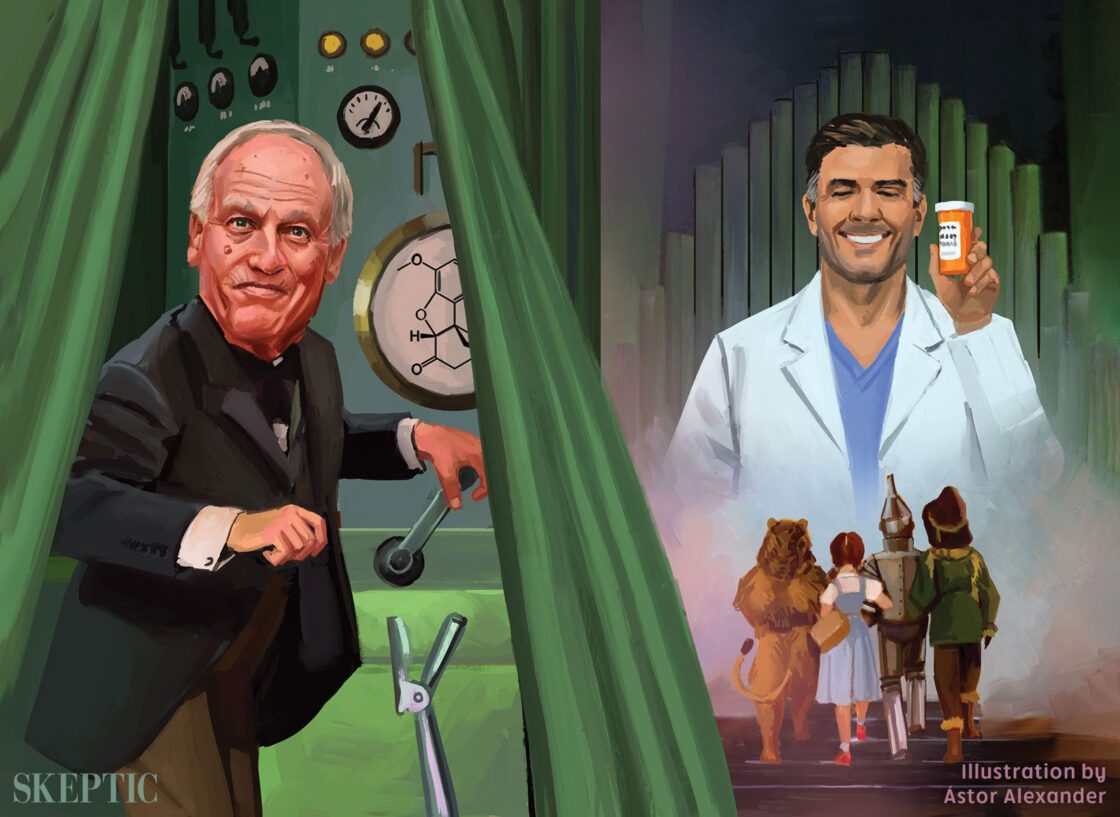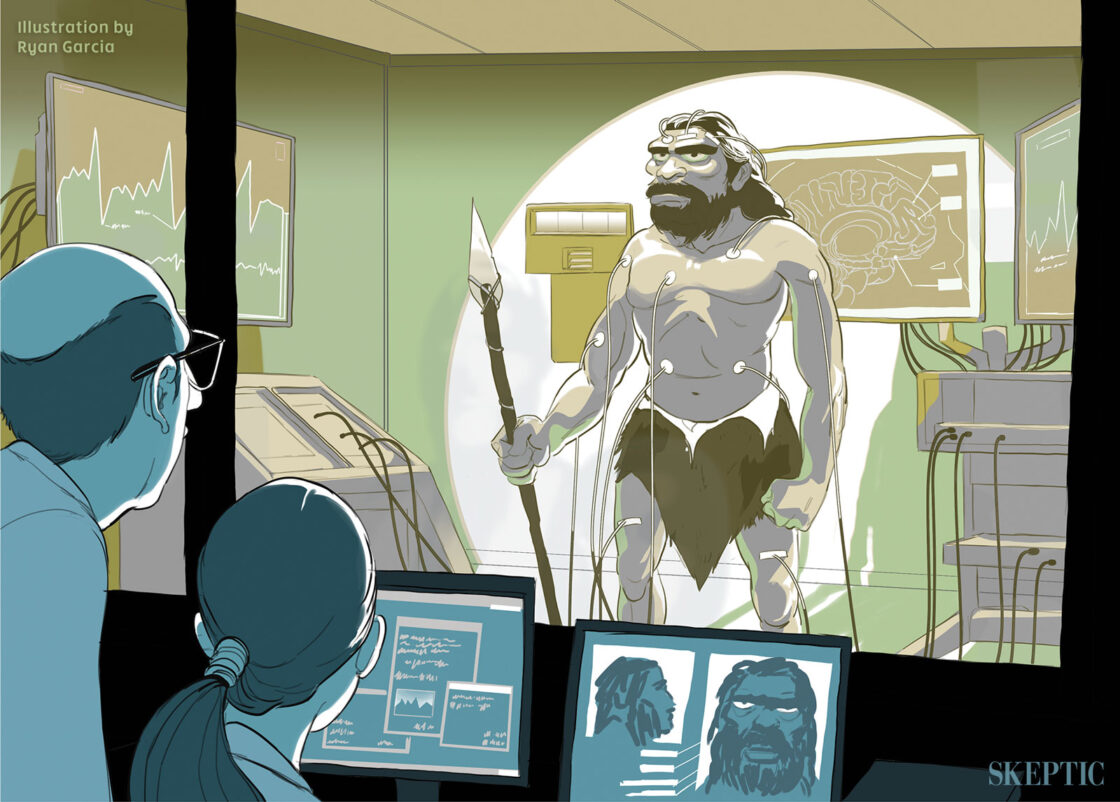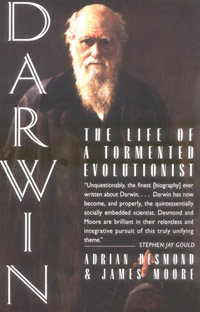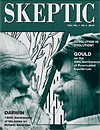SEVERAL YEARS AGO a Darwin scholar suggested that “the lack of a good up-to-date biography [of Darwin] is less innocent than it might appear. It may reveal … a state of ferment, which is the least suited for a synthesis, even for a provisional one” (La Vergata, 1985, p. 964). The new biography of Darwin by Adrian Desmond and James Moore is not a provisional synthesis but it is more than another fragmented biography. The authors integrate Darwin into the complex social and scientific network of 19th-century Britain, giving his life and theories novel social and political dimensions.
The authors claim that the contradictions of Darwin’s life have never been resolved: “How then did such a wealthy Whig gentleman break the impasse and make evolution acceptable? How did he present it as an underpinning of middle-class values… Understand Darwin’s scientific status, his social obligations, his Dissenting heritage, the political context, and the contradictions start to resolve themselves” (p. xix).
With their shrewd knowledge of the politics of 19th-century evolution and of English religious and social life gained from earlier writings (Desmond, 1984, 1989; Moore, 1979, 1985), the authors develop a lively and informative study on the social nature of Darwin’s theories of evolution. The first two-thirds of the book which bring Darwin to age 49 — the year before he published the Origin of Species — are particularly effective in giving a sense of immediacy and freshness because of their voluminous quotations from the newly published Darwinian correspondence (Burkhardt and Smith, 1985–1991).
As befits a social history of Darwin and his theories, Desmond and Moore focus on the social, political and religious context of Darwin’s theories, and his personal response to that context, rather than on an internal analysis of the theories themselves. The authors are aware that the verification of Darwin’s theories does not depend on the context of the discovery nor on the psychology of the discoverer.
The social history of Darwin’s life and theories brings into bold relief Darwin’s compelling need for respectability: as a “Whig gentleman on a private fortune … [Darwin] relished his freedom to follow his own pursuits, to make his home a lab, as the rich had done for centuries. He was not one for salaried science … He was concerned with standards of behavior, however, and he shared his family’s abhorrence of the “‘fierce & licentious’ radicals” (p.199). Darwin insisted on living a proper lifestyle “with the proprieties observed to the last detail. [He] was even more of a stickler for etiquette than [his wife] Emma. Permitting her maid to forego a bonnet led to a terrible tiff. He was horror-struck…” (p. 282).
Moore quotes elsewhere Darwin’s son, William, who saw in his father a “deep respect for authority of all kinds and for the laws of Nature. He could not endure the feeling of breaking any law of the most trivial kind … He both felt and liked to show his respect for the position and title of others, and was very careful in addressing them by letter in the proper form … he had an instinctive admiration for an old title and old family, and used laughingly to say how deeply he admired a Lord…” (Moore, 1985, p. 475). According to Desmond and Moore, Darwin delayed publishing his theory of the transmutation of species, in large part, because “he was frightened for his respectability. For a gentleman among the Oxbridge set, priming itself to guard man’s soul against the socialist levellers, publishing would have been tantamount to treachery — a betrayal of the old order” (p. 296).
While Darwin was developing his concept of the theory of natural selection in his notebooks, he was moving socially and politically in a world of Malthusian Whigs: “His family and friends were justifying the reforms, rationalizing middle-class values, underpinning competition, arguing for free trade, factory expansion, and the removal of religious disabilities. They saw their social world as part of nature, itself struggling and progressing in accordance with God’s laws. (p. 218)
In the Malthusian struggle for existence, Darwin found “a mechanism that was compatible with the competitive, free-trading ideals of the ultra-Whigs. The transmutation at the base of his theory would still be loathed by many. But the Malthusian superstructure struck an emotionally satisfying chord; an open struggle with no hand-outs to the losers was the Whig way, and no poor-law commissioner could have bettered Darwin’s views. He had broken with the radical hooligans who loathed Malthus. Like the Whig grandee — safe, immune, their own world characterized by noblesse oblige — Darwin was living on a family fortune, and thrusting a bitter competition on a starving world for its own good” (p. 267).
When later in life, Alfred Wallace, the co-discoverer of natural selection, wrote to Darwin that the Malthusian struggle for existence applied only to the non-human world and could not be used to justify human inequality, Darwin replied that he hoped Wallace was not turning into a “renegade to natural history” (p. 653). It is not surprising that Darwin became a booster of the self-help values of Samuel Smiles. In the tension between Darwin’s compelling need to present and defend his controversial theory of evolution, and his equally compelling need to deny publicly any unrespectable religious and political implications of his theories, it may be possible to find the source of some of the confusion about what Darwin really meant. Desmond and Moore suggest that Darwin’s “worries about his heresies made him repeatedly ill … ” (p. 269). Whether this tension was indeed the cause of Darwin’s illness in adulthood cannot, of course, be proven. That he was seriously ill there is no doubt. When he was in his middle fifties, Darwin made a somewhat incoherent list of his symptoms: “For 25 years extremely spasmodic daily & nightly flatulence: occasional vomiting, on two occasions prolonged during months. Vomiting preceded by shivering, hysterical crying, dying sensations or half-faint & copious very pallid urine. Now vomiting & every passage of flatulence preceded by ringing of ears, treading on air & vision focus & black dots…” (p. 531).
For many historians of science the most fascinating part of this new biography will be the innumerable illustrations of the complex social network in the scientific community which Darwin manipulated with great skill. His social and scientific status reinforced each other and the establishment networks acted favorably on his requests. He received and dispensed patronage, used friends and acquaintances to secure specimens and materials for his endless and ingenious experiments, and utilized British scientific institutions and his extraordinarily large number of correspondents in Britain and abroad to pave the way in advance for the favorable reception of his scientific theories.
That there were controversies over the religious and political implications of the Origin of Species was unavoidable, given the reigning religious beliefs of Victorian England and the struggle for political reform. But Darwin gave no public comfort, regardless of his private beliefs, to radical positions which might dilute the respectability of his scientific status. In 1871 Francis Abbot asked Darwin for an advertising endorsement for his American journal advocating a non-Christian, free-thinking religion where “lies the only hope of the spiritual perfection of the individual and the spiritual unity of the race.” At first Darwin demurred, then endorsed Abbot’s post-Christian evolutionary beliefs: “I admire them from my inmost heart, & I agree to almost every word” (p. 591). But when the attempt to seat an atheist in the British Parliament in 1880 led to a public outcry against atheism, Darwin worried that news of his American endorsement might find its way back to England. Although he had continued to read and generously subscribe to Abbot’s journal, Darwin instructed William to write to Abbot: “My Father … had no intention that his words should be used for this purpose” (p. 643). Abbot withdrew the endorsement.
Darwin knew and feared from his own experience and that of his contemporaries that the religious and political implications of evolutionary theories would offend orthodox opinion. When Lord Palmerston apparently suggested Darwin’s name for the Honors List before the publication of the Origin, he received support from Prince Albert. But once the Origin appeared, Queen Victoria’s ecclesiastical advisers including Samuel Wilberforce, Bishop of Oxford, advised the Queen that a knighthood would imply approval of the book.
If Darwin did not receive honors from the Queen, there was nonetheless a change in the public perception of Darwin’s theories by 1882 that led the nation to bestow its highest honors on Darwin at his death. Darwin and his friends in the scientific community were largely responsible for that change of elite opinion which led to his apotheosis in 1882. Darwin’s exemplary life of utmost respectability, his extraordinary and selfless dedication to lifelong research despite debilitating illness, and the international recognition of his unparalleled achievements in evolutionary science led even those who did not accept his theories to pay tribute to Darwin.
John Morley wrote in the Pall Mall Gazettein 1882 that the Darwinian creed “reappears under a hundred disguises in works on law and history, in political speeches and religious discourses, in artistic theories and vague social speculations … If we try to think ourselves away from it, we must think ourselves entirely away from our age” (p. 677). Darwin’s friends used their connections to have him buried in Westminster Abbey with the great pomp and circumstance which Darwin had admired in other funerals. It was a move strongly supported by the London quality newspapers which saw in the Abbey service the “reconciliation between Faith and Science” (p. 671). Because the theory of natural selection was so little understood, it seemed by 1882 that the general idea of evolution was not necessarily incompatible with the traditional religious ideals which underlay English society. Darwin’s respectability in society and in the new scientific priesthood had made him a secular saint.
Readers of this well-written biography will not find much about the learned controversies over the finer points of Darwin’s theory of natural selection and other aspects of his theory of evolution. Such controversies are the staple fare of the Darwin industry and are not the purpose here. The thrust of this biography is that Darwin’s life and theories cannot be properly understood if separated from the social, religious and political context that molded their expression.
Although Desmond and Moore amply document their social history, their praiseworthy attempt to place Darwin’s theories within their social context sometimes exposes awkward seams in the narrative when they move from specific analysis to historical background. Too often they juxtapose a specific contemporary political event with a specific research activity of Darwin as though one necessarily throws light on the other. In discussing the Crimean War of l854, for example, they describe the siege of the beachhead at Sebastopol followed by the comment: “Darwin was thinking about the parallel warfare of nature, and how sea-borne invaders, seeds and fruits, frogs and snails, could establish a beachhead on alien terrain and oust the occupiers” (p. 419).
There is nothing in either the biography of Desmond and Moore or in the detailed writings of Darwin on the theory of natural selection to suggest that the Crimean War played a specific role in the development of his theory. Nonetheless such historical background narrative is helpful to the social history of Darwin when its purpose is simply to furnish historical ambience rather than to imply a one-to-one relation.
The Darwin industry has increasingly recognized, if somewhat obliquely, the necessity of understanding the social nature of Darwin’s theories. David Kohn, editor of The Darwinian Heritage, a rich summary of recent work by the Darwin industry, suggested that “the way to cope with the coming flood of [Darwin’s] correspondence will be for Darwin scholars to become social historians … I say this because the mass of Darwin’s letters deals with the construction and maintenance of chains and networks of informants, which Darwin manipulated to provide much of the evidentiary substrata for his research program” (Kohn, 1985, p. 4).
As Darwin scholars increasingly concentrate on the social network of the scientific community surrounding Darwin, it is possible that they may gain as well a clearer understanding of the social nature of Darwin’s theories and perhaps eventually of the Darwin industry itself. Before the 1959 centenary of the publication of the Origin, there was no Darwin industry and Darwin was considered a first-rate biologist but a second-rate philosophical thinker. The centenary celebrated not Darwin but modern evolutionary biology. In the following decade, a revisionist view arose which suggested that Darwin was a profound thinker not only in biology but also in “logic, metaphysics and ethics. It has taken 100 years to appreciate fully that Darwin’s conceptual framework is, indeed, a new philosophical system” (Mayr, 1964, p. xviii).
The revisionist view of Darwin has become the major theme of the Darwin industry. David Kohn suggests that the implicit premise of the Darwin industry “is that Charles Darwin was a thinker of profound intellect and influence. Indeed what characterizes the present community is a belief in the importance of Darwin. This high regard for Darwin is its central tenet” (Kohn, 1985, p. 1–2). It appears that Darwin is well on his way to attaining secular sainthood for a second time. A social history of the belief system of the Darwin industry might offer insights into the present evaluation of Darwin as worthwhile as those found in this excellent biography.
Bibliography
- Burkhardt, F., and Smith, S., eds. The Correspondence of Charles Darwin. 7 vols. Cambridge: Cambridge U.P., 1985–1991.
- Desmond, A. Archetypes and Ancestors: Palaeontology in Victorian London, 1850-1875. Chicago: University of Chicago Press, 1984. ——aaical London. Chicago: University of Chicago Press, 1989.
- La Vergata, A. “Images of Darwin: A Historiographic Overview.” In Kohn,D.,ed. The Darwinian Heritage. Princeton, NJ: Princeton U.P., 1985.
- Kohn, D., ed.The Darwinian Heritage. Princeton, NJ: Princeton U.P.,1985.
- Mayr, E., ed. On the Origin of Species by Charles Darwin. A Facsimile of the First Edition. Cambridge, MA: Harvard U.P., 1964.
- Moore, J.R. The Post-Darwinian Controversies: A Study of the Protestant Struggle to come to Terms with Darwin in Great Britain and America, 1870–1900. Cambridge: Cambridge U.P., 1979.
- ——“Darwin of Down: The Evolutionist as Squarson-Naturalist.” In Kohn,D.,ed., The Darwinian Heritage. Princeton, NJ:Princeton U.P. 1985.
This article can be found in
volume 01 number 3
Revolution in Evolution?
Darwin & Gould Investigate Edgar Cayce; 20 years of Punctuated Equilibrium; Historic 1842 Sketch on Evolution; the Nature of Change; Darwinian Culture…
BROWSE this issue >
ORDER this issue >
This article was published on November 15, 1993.


















